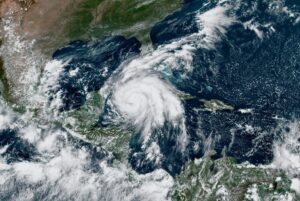
Preparing for Hurricane Ian

Preparing for Hurricane Ian
The International Code Council is monitoring Hurricane Ian as it rapidly intensifies and moves northward to take aim at Florida, Alabama, Georgia, and South Carolina later this week. Ian is forecasted to be a strong Category 2 hurricane with forecast winds of 105 mph or more. Life-threatening storm surge is possible along much of the Florida west coast, with the highest risk from Fort Myers to the Tampa Bay region. Residents in these areas should listen to advice given by state and local officials including the
Florida Division of Emergency Management.
Hurricane-force winds are possible in the hurricane watch area in west-central Florida beginning Wednesday morning with tropical storm conditions possible by late Tuesday. Residents in this area should ensure that they have their hurricane plan in place. Heavy rainfall will increase across the Florida Keys and south Florida Tuesday, spreading to central and northern Florida Wednesday and Thursday, potentially causing flash, urban and small stream flooding. Significant prolonged river flooding is likely across central Florida.
For the latest forecast and additional safety information, please visit the National Hurricane Center and the Code Council’s hurricane safety and resources page.
Managing Your Flood Risk
With Hurricane Ian in the headlines, the Code Council and our partners at the Federal Emergency Management Agency (FEMA) remind everyone that floods can happen anywhere, not just during or after a hurricane. Most homeowner’s insurance does not cover flood damage. Flood insurance is a separate policy that can cover buildings, the contents in a building, or both, so it is important to protect your most important financial assets including your home, your business, and your possessions.
Mitigation Opportunities
The Code Council and FEMA support community-based mitigation strategies that decrease risk and repetitive loss while increasing a community’s resilience to disasters. As part of those strategies, the adoption and enforcement of building codes has been identified as one of the five priorities of FEMA’s FY2022 BRIC program. Eligible building code adoption and enforcement activities for the proposed BRIC program are activities that:
- Evaluate adoption and/or implementation of codes that reduce risk
- Enhance existing adopted codes to incorporate more current requirements or higher standards
- Develop professional workforce capabilities through technical assistance and training
The BRIC program application period is currently open, closing on January 27, 2023. For more information on the disaster-resistant provisions of the International Codes or the FEMA BRIC program, contact your Code Council Government Relations Regional Manager or Karl Fippinger, Vice President - Government Relations, Fire and Disaster Mitigation at kfippinger@iccsafe.org.
Disaster Recovery Resource for Code Officials
When disasters strike, codes and standards serve as a baseline for the return to safe, sanitary, and habitable buildings. Code officials and their floodplain management counterparts rely on support from emergency managers and community leaders to help secure the critical resources needed to ensure the health, safety, and welfare of the community. To that end, FEMA recently announced a new
disaster policy specifically aimed at providing much needed assistance for code officials and floodplain managers during disaster response and initial recovery for up to 180 days following a major disaster declaration. Learn how to apply for building code administration and enforcement assistance here. This policy, administered under FEMA’s program, offers reimbursement for critical community functions such as building code administration, code enforcement, floodplain management administration and enforcement, and conducting substantial damage surveys inspections in affected communities. For more information, visit the Code Council’s resource page.
Disaster Response Alliance
As an aid to community disaster response, the Code Council and the National Council of Structural Engineers Associations (NCSEA) sponsor the
Disaster Response Alliance (DRA). The DRA maintains a national database of skilled, trained, and certified building safety professionals who are standing by and ready to assist communities in need.
The DRA has assembled a cadre of skilled code officials, engineers, and others from across the country who are willing to assist with post-disaster safety assessments, building damage assessments, inspections, and surge support for other code-related functions. The Disaster Response Alliance brings together skilled, volunteer second responders in one place for easy access and quick mobilization. Federal, state, local, tribal, and territorial entities may
request assistance directly through the DRA website.
Interested in becoming a DRA resource?
The DRA is always looking for volunteers. If you or someone you know is interested in becoming a DRA second responder resource, please visit the Volunteer Now link on the DRA web site. Architects, engineers, and building safety professionals willing to make a difference during times of disaster are encouraged to apply. The DRA is also looking for individuals with specialized skills, knowledge, or abilities such as plans examiners, permit technicians, and building inspectors.



